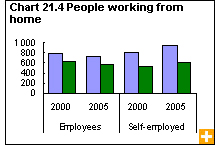Common menu bar links
Fewer employees work at home
Archived Content
Information identified as archived is provided for reference, research or recordkeeping purposes. It is not subject to the Government of Canada Web Standards and has not been altered or updated since it was archived. Please contact us to request a format other than those available.
With the widespread technology in Canadian homes, teleworking would presumably be an option for many workers. The numbers show, however, that the trend has gathered some momentum, but has not taken off.
The practice of employees doing some or all of their regularly scheduled work at home has levelled off in recent years, slipping from 10.2% of employees in 2000 to 9.8% in 2005, or about 1.3 million workers.
The desire to telework can come from the employer or employee, or both. One in four teleworkers said in 2005 that working at least some of the time at home was a requirement of their job. Others cited personal advantages to working at home, such as saving time and money on commuting, and more easily balancing work and family demands. On the negative side, working at home may reduce an employee’s social circle, stifle career advancement, or even increase workload.
For employers, telework arrangements may boost employee productivity, reduce expenses for work space, improve recruitment and retention of employees, and reduce absenteeism. The most commonly cited disadvantages are difficulties co-ordinating work and communicating with the employee, lack of control over quality of work, and information security.
The technology that makes telework possible in the first place is becoming so portable that employees can use laptops, cell phones and other devices to work almost anywhere—such as in cars or airports—and thus they do not need to use a home office.
Telework is more pervasive among the self-employed, who generally have more flexibility in choosing their workplace: it rose from 49.5% of the self-employed in 2000 to 54.6% in 2005.



